【原】Coursera—Andrew Ng机器学习—编程作业 Programming Exercise 1 线性回归
作业说明
Exercise 1,Week 2,使用Octave实现线性回归模型。数据集 ex1data1.txt ,ex1data2.txt
单变量线性回归必须实现,实现代价函数计算Computing Cost 和 梯度下降Gradient Descent。
多变量线性回归可选,实现 特征Feature Normalization、代价函数计算Computing Cost 、 梯度下降Gradient Descent 和 Normal Equations 。

文件清单
- ex1.m
- ex1_multi.m
- ex1data1.txt - ex1.m 用到的数据组
- ex1data2.txt - ex1_multi.m 用到的数据组
- submit.m - 提交代码
- [*] warmUpExercise.m
- [*] plotData.m
- [*] computeCost.m
- [*] gradientDescent.m
- [+] computeCostMulti.m
- [+] gradientDescentMulti.m
- [+] featureNormalize.m
- [+] normalEqn.m
* 为必须要完成的
+ 为可
背景:假设我们现在是个连锁餐厅的老板,已经在很多城市开了连锁店(提供训练组),现在想再开新店,需要通过以前的数据预测新开的店的收益。
ex1data1.txt 提供所需要的训练组,第一列是城市人口,第二列是对应的收益。负值代表着亏损。
结论
当数据的特征维度比较小的时候,使用正规方程方法不需要进行特征归一化,而且结果稳定。梯度下降有可能得到局部最优解,导致结果不同。
注意矩阵计算的一些问题,求和前面一项需要转置。
必做题 单变量线性回归
一、warmUp
单变量线性回归入口在ex1.m
warmUpExercise.m
A = eye()
二、绘制数据图
我实现的 plotData.m:
plot(x,y,'rx', 'MarkerSize', );
xlabel('Population of City in 10,000s');
ylabel('Profit in $10,000s');
title('POPULATION AND PROFIT');
ex1.m 中的调用:
%% ======================= Part : Plotting ======================= data = load('ex1data1.txt');
X = data(:, ); y = data(:, );
m = length(y); % number of training examples
plotData(X, y);
运行效果如下:
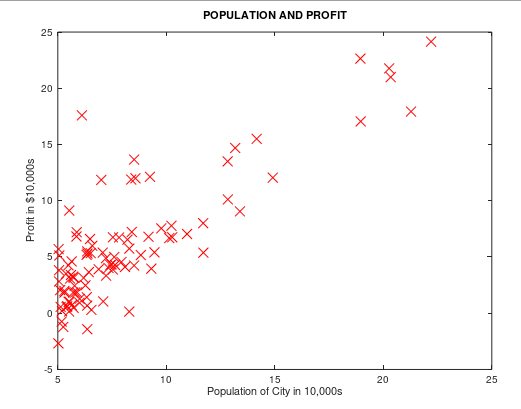
三、代价函数
我实现的 computeCost.m:
function J = computeCost(X, y, theta) m = length(y); % number of training examples
J = ;
predictions = X * theta; % predictions of hapothesis on all m examples
sqrErrors = (predictions - y) .^ ; % squared errors .^ 指的是对数据中每个元素平方 J = / ( * m) * sum(sqrErrors);
end
四、梯度下降

我实现的 gradientDescent.m
矩阵性质:(AB)T =BTAT
function [theta, J_history, theta_history] = gradientDescent(X, y, theta, alpha, num_iters) m = length(y); % number of training examples
J_history = zeros(num_iters, );
theta_history = zeros(, num_iters); % 【改动】使用 ×iteration维矩阵,保存theta每次迭代的历史 for iter = :num_iters % 这里为了方便理解 拆的比较细,可以组合成一步操作 theta = theta - (alpha / m) * X' * (X * theta - y)
% prediction h(x) m×2矩阵 * 2×1向量 = m维列向量
predictions = X * theta;
% error h(x)-y m维列向量
errors = predictions - y; %
% derivative of J() m维行向量 * m×2矩阵 = 2维列向量
lineLope = X' * errors;
% theta 2维列向量
theta = theta - (alpha / m) * lineLope; %
J_history(iter) = computeCost(X, y, theta); % Save the cost J in every iteration
theta_history(:,iter) = theta; % 给theta_history 第iter列赋值
end end
五、绘制预测曲线
ex1.m 中的调用:
%% =================== Part : Cost and Gradient descent =================== % 设置 X 和 theta
X = [ones(m, ), data(:,)]; % Add a column of ones to x
theta = zeros(, ); % initialize fitting parameters % 设置迭代次数和学习速率
iterations = ;
alpha = 0.01;
% compute and display initial cost 计算theta=[;]时代价
J = computeCost(X, y, theta);
% further testing of the cost function 计算theta=[-;]时代价
J = computeCost(X, y, [- ; ]);
fprintf('\nRunning Gradient Descent ...\n') % 【改动1】改为获取多个返回值,J_history保存每次迭代的代价,theta保存每次迭代的theta0和theta1
% 原:theta = gradientDescent(X, y, theta, alpha, iterations);
[theta,J_history,theta_history] = gradientDescent(X, y, theta, alpha, iterations); % Plot the linear fit 在数据图上绘制最终的拟合直线
hold on; % keep previous plot visible
plot(X(:,), X*theta, '-')
legend('Training data', 'Linear regression')
hold off % don't overlay any more plots on this figure
运行结果如下:
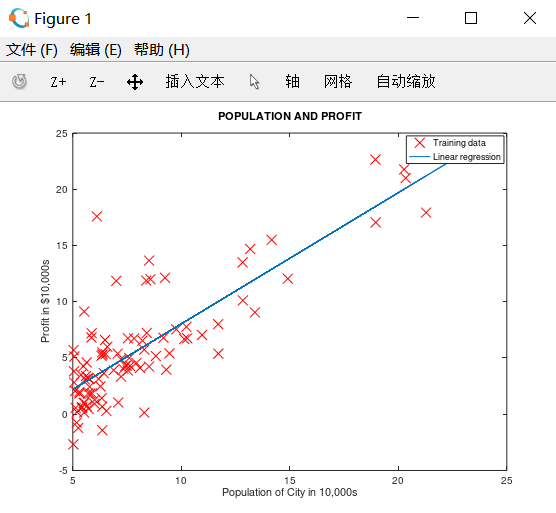
四、绘制cost和theta变化曲线
自己加的功能。在ex1.m中增加以下代码,绘制图像。展示迭代过程中 cost 和 theta 的变化曲线
% --------------【改动2】绘制代价和theta变化曲线 start --------------
fprintf('Size of J_history saved by gradient descent:\n');
fprintf('%f\n', size(J_history));
iterX = [:iterations]'; % 生成图像横坐标,迭代次数 % 绘左侧图,展示迭代过程中代价的变化曲线
subplot(,,);
plot(iterX, J_history, '-','linewidth',); % 绘制代价函数曲线
title('cost of each step'),
xlabel('iteration'),ylabel('value of cost'),
legend('value of cost'); % 绘右侧图,展示迭代过程中theta的变化曲线
theta0_history = theta_history(,:);
theta1_history = theta_history(,:);
subplot(,,);
plot(iterX,theta0_history,'-','linewidth',);
hold on;
plot(iterX,theta1_history,'-','linewidth',,'color','r');
title('theta of each step'),xlabel('iteration'),ylabel('value of theta'),legend('theta0','theta1');
% --------------【改动2】绘制代价和theta变化曲线 end -------------- % Predict values for population sizes of , and ,
predict1 = [, 3.5] * theta;
fprintf('For population = 35,000, we predict a profit of %f\n',...
predict1*);
predict2 = [, ] * theta;
fprintf('For population = 70,000, we predict a profit of %f\n',...
predict2*);
输出如下:

五、绘制代价函数三维曲线 和 等高线图
ex1.m 调用:
1、初始化 theta0 为(-10,10)均分100个点,theta1 为(-1,4)均分100个点,J_vals 为100 * 100的数组
这里使用了Matlab中的均分计算指令 linspace(x1,x2,N) ,用于产生x1、x2之间的N点行线性的矢量。其中x1、x2、N分别为起始值、终止值、元素个数。默认N为100。
2、循环计算每组(theta0,theta1),用 J_vals 保存对应的代价cost。
%% ============= Part : Visualizing J(theta_0, theta_1) =============
fprintf('Visualizing J(theta_0, theta_1) ...\n') % Grid over which we will calculate J
theta0_vals = linspace(-, , );
theta1_vals = linspace(-, , ); % initialize J_vals to a matrix of 's
J_vals = zeros(length(theta0_vals), length(theta1_vals)); % Fill out J_vals
for i = :length(theta0_vals)
for j = :length(theta1_vals)
t = [theta0_vals(i); theta1_vals(j)];
J_vals(i,j) = computeCost(X, y, t);
end
end % Because of the way meshgrids work in the surf command, we need to
% transpose J_vals before calling surf, or else the axes will be flipped
J_vals = J_vals';
% Surface plot
figure;
surf(theta0_vals, theta1_vals, J_vals)
xlabel('\theta_0'); ylabel('\theta_1'); % Contour plot
figure;
% Plot J_vals as contours spaced logarithmically between 0.01 and
contour(theta0_vals, theta1_vals, J_vals, logspace(-, , ))
xlabel('\theta_0'); ylabel('\theta_1');
hold on;
plot(theta(), theta(), 'rx', 'MarkerSize', , 'LineWidth', );
3、将theta0作为X坐标,theta1作为Y坐标,J_vals作为Z坐标,绘制三维图形

4、将theta0作为X坐标,theta1作为Y坐标,绘制J_vals的等高线图
5、在等高线图中,标记上面求出的使代价函数最小的 theta0,theta1点的位置。在等高线中心

这些图像的目的是为了展示 随着Θ0 和 Θ1 的改变,J值的变化。(在2D轮廓图中比3D的更直观)。最小点是Θ0 和 Θ1最适点, 每一步梯度下降都会更靠近这个点。
可以通过旋转看到为什么叫“轮廓图”:
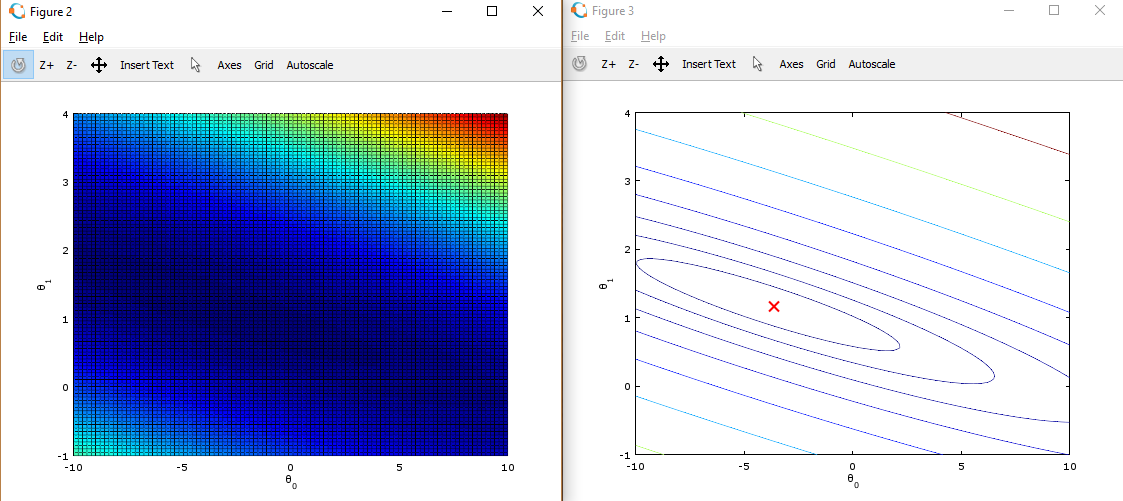
选做 多变量线性回归
一 、特征归一化
需要用特性放缩让数据的范围缩小,使得梯度下降计算的更快:
- 计算每个特性的平均值(mean)
- 计算标准差(standard deviations)
- 特性放缩(feature scaling)
* 这里利用的是标准差(standard deviation),也可以使用差值(max - min)。
featureNormalize.m 如下:
1 function [X_norm, mu, sigma] = featureNormalize(X)
7
9 X_norm = X;
10 mu = zeros(1, size(X, 2)); % 1行,列数和X相同
11 sigma = zeros(1, size(X, 2));
12
13 % ====================== YOUR CODE HERE ======================
29 mu = mean(X);
30 sigma = std(X);
32 X_norm = (X_norm - mu) ./ sigma;
35
36 end
二、代价函数和梯度下降
因为在单变量线性回归中,使用的是向量化的计算方法,对于多变量线性回归同样适用。不需要重新写
computeCostMulti.m 和 computCost.m 一样,gradientDescentMulti.m 和gradientDescent.m 一样
ex1_multi.m 里的调用:
%% ================ Part : Gradient Descent ================
alpha = 1.2;
num_iters = ; % Init Theta and Run Gradient Descent
theta = zeros(, );
[theta,J_history] = gradientDescentMulti(X, y, theta, alpha, num_iters); % Plot the convergence graph
figure;
plot(:numel(J_history), J_history, '-b', 'LineWidth', );
xlabel('Number of iterations');
ylabel('Cost J'); % Estimate the price of a sq-ft, br house
% 这里要注意,需要把输入的值进行 normalize,然后才能代入预测方程中
predict_x = [,];
predict_x = (predict_x - mu) ./ sigma;
price = [, predict_x] * theta;
三、正规方程
公式:

normalEqn.m 实现:
function [theta] = normalEqn(X, y)
theta = zeros(size(X, ), );
theta = pinv(X' * X) * X' * y
end
ex1_multi 里的调用:
%% ================ Part : Normal Equations ================
% predict the price of a sq-ft, br house. data = csvread('ex1data2.txt'); % 重新加载数据
X = data(:, :);
y = data(:, );
m = length(y);
% Add intercept term to X
X = [ones(m, ) X];
% Calculate the parameters from the normal equation
theta = normalEqn(X, y); % 使用正规方程进行计算
28 % ====================== YOUR CODE HERE ======================
price = [, , ] * theta; % 预测结果 % ============================================================
四、测试
运行结果:
Loading data ...
First examples from the dataset:
x = [ ], y =
x = [ ], y =
x = [ ], y =
x = [ ], y =
x = [ ], y =
x = [ ], y =
x = [ ], y =
x = [ ], y =
x = [ ], y =
x = [ ], y =
Program paused. Press enter to continue.
Normalizing Features ...
1.00000000 0.13000987 -0.22367519
1.00000000 -0.50418984 -0.22367519
1.00000000 0.50247636 -0.22367519
1.00000000 -0.73572306 -1.53776691
1.00000000 1.25747602 1.09041654
1.00000000 -0.01973173 1.09041654
1.00000000 -0.58723980 -0.22367519
1.00000000 -0.72188140 -0.22367519
1.00000000 -0.78102304 -0.22367519
1.00000000 -0.63757311 -0.22367519
1.00000000 -0.07635670 1.09041654
1.00000000 -0.00085674 -0.22367519
1.00000000 -0.13927334 -0.22367519
1.00000000 3.11729182 2.40450826
1.00000000 -0.92195631 -0.22367519
1.00000000 0.37664309 1.09041654
Running gradient descent ...
Theta computed from gradient descent:
334302.063993
100087.116006
3673.548451
(1)当 α = 0.05,预测一个1650 sq-ft, 3 br house 的房屋的售价。梯度下降和正规方程的预测值不同:
68 Predicted price of a 1650 sq-ft, 3 br house (using gradient descent):
69 $289314.620338
81
82 Predicted price of a 1650 sq-ft, 3 br house (using normal equations):
83 $293081.464335

(2)当 α = 0.15,cost 曲线如下。两个方法预测值都是 $293081.464335:

(3)当 α = 1,cost 曲线如下。两个方法预测值都是 $293081.464335:
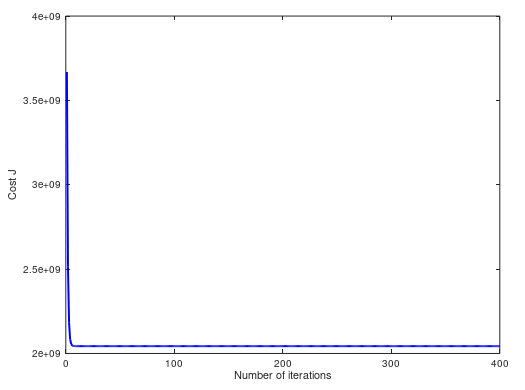
(4)当 α = 1.2,cost 曲线如下。两个方法预测值都是 $293081.464335:
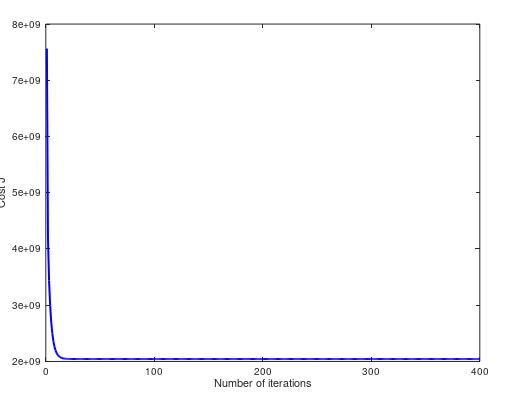
(5)当 α = 1.3,cost 曲线如下。两个方法预测值不同 $293157.248289 ,$293081.464335:

完整代码:https://github.com/madoubao/coursera_machine_learning/tree/master/homework/machine-learning-ex1/ex1
最新文章
- 【代码笔记】iOS-将400电话中间加上-线
- who命令的总结
- Eclemma各种安装方式以及安装失败解决
- Python之SQLAlchemy学习
- 介绍开源的.net通信框架NetworkComms框架之八 UDP通信
- nginx 优化
- poj - 2386 Lake Counting && hdoj -1241Oil Deposits (简单dfs)
- git 和 svn的区别(转)
- JS远程获取网页源代码的例子
- iOS搜索框UISearchBar 分类: ios技术 2015-04-03 08:55 82人阅读 评论(0) 收藏
- 响应HttpServletResponse
- web基础系列(五)---https是如何实现安全通信的
- 【java】网络socket编程简单示例
- 【转载】漫谈HADOOP HDFS BALANCER
- C# WMI 远程PC(开机、关机、重启)
- webstorm使用问题总结
- [Swift]LeetCode106. 从中序与后序遍历序列构造二叉树 | Construct Binary Tree from Inorder and Postorder Traversal
- winform程序中chart图的使用经验(chart图的更新)
- HttpServletRequest.getContextPath()取得的路径
- linux关闭触摸板